VENEZUELA
Economy

Economy

Cities in VENEZUELA
| Caracas |
Popular destinations VENEZUELA
| Isla margarita |
Economy
General
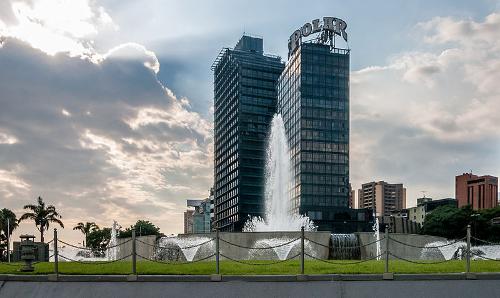 Caracas business center, VenezuelaPhoto: Wilfredor in the public domain
Caracas business center, VenezuelaPhoto: Wilfredor in the public domain
Until the emergence of petroleum extraction in the 1920s, agriculture was the most important economic activity, with the export of coffee playing a major role. Commercial oil exploitation started in 1917 and since then mining has undergone an explosive development;Between 1928 and 1969, Venezuela was the most important petroleum exporter in the world, in 1994 the sixth (after, among others, Saudi Arabia, Iran, Norway and the United Arab Emirates). Especially since the beginning of the Second World War, petroleum has formed the basis of the economy.
After the nationalization of iron ore mining and processing in 1975 and of the foreign oil companies in 1976, the government already had a great influence on the economy. even reinforced;in almost all areas of the economy, the government had direct or indirect interests in production and trade through semi-autonomous institutions. From 1989, however, the government has initiated a privatization program designed to attract foreign investment. Oil revenues have been channeled into a major industrialization program, but capital flight, high debt and corruption have nevertheless put the country in economic trouble.
In 2017, 7.3% of the economically active population was employed in agriculture (and livestock), 21.8% in mining and industry and 70.9% in trade and services. The share of these sectors in GDP in 2017 was: agriculture and livestock farming 4.7%, mining and industry 40.4% and trade and services 54.9%. Growth in 2017 is heavily negative at -14%, inflation is extremely high (more than 1000% in 2017) and the government is dependent on oil and import tariffs for its revenues. In 2017, 27.1% of the population was unemployed and 20% of the population lives below the poverty line.
A downturn in economic development is not an unknown phenomenon in Venezuela. The dependence on oil revenues (almost 90% of exports) makes the Venezuelan economy extremely vulnerable to fluctuations in the development of the world economy (so-called ‘boom-bust’ cycle).
Agriculture, livestock, forestry and fishing
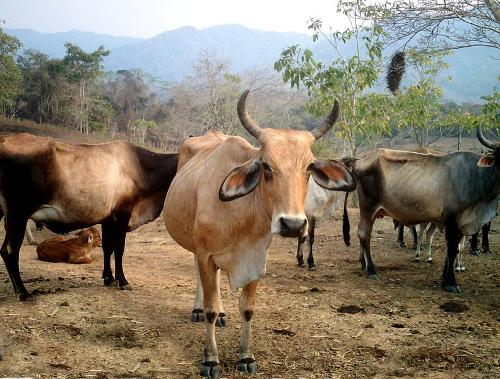 Cattle, VenezuelaPhoto: Wilfredor CC 3,0 no changes made
Cattle, VenezuelaPhoto: Wilfredor CC 3,0 no changes made
Approximately 20% of the total land area is suitable for agricultural purposes, 70% of which is state-owned. In 1960 a land reform law came into effect;since then 8.3 million ha of land has been divided among nearly 150,000 farming families. Approx. 25% of the land came from expropriated large land ownership. The focus of land reform has always been on the cultivation of new land, the improvement of infrastructure and lending. However, the government mainly supports profitable medium-sized and large businesses, while small farmers have difficult access to credit and other support for their business.
The main agricultural areas are in the Andean valleys and at the foot of this mountain range, both on the Llanos side and on the Lake Maracaibo side. The main products are corn, coffee, legumes, various kinds of bananas, sugar cane and cotton;peanuts, citrus fruits, onions, tomatoes, cocoa, tobacco and vegetables are also grown. The production of a number of crops is insufficient for domestic consumption.
Cattle are mainly reared in central Llanos, the area south of Lake Maracaibo, and near major cities along the coast;the majority are cattle for slaughter, reared on extensive large farms. In addition, pigs, sheep, horses and poultry are kept.
The country's large wood resources are almost never and often improperly exploited, leading to deforestation and erosion. Traditionally, fishing has been an important livelihood for coastal residents;the government is subsidizing the modernization of the fleet. Sea fish and shrimp are mainly used for domestic consumption and processed into preserves and fish meal. The rest will be executed.
Mining and energy supply
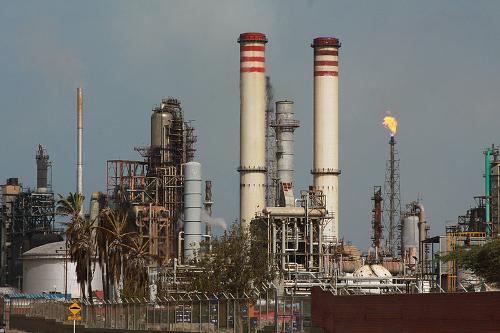 Oil refinery in VenezuelaPhoto: Luisovalles CC 3.0 Unported no changes made
Oil refinery in VenezuelaPhoto: Luisovalles CC 3.0 Unported no changes made
Venezuela is very rich in minerals, of which petroleum is the most important. Oil extraction and exploitation were in the hands of foreign companies from the start. Since their nationalization in 1976, major companies such as Shell, Gulf and Creole have been operating under new names as Venezuelan companies as part of a state-owned company established in 1975 that controls exploration, production, processing and sales. Most of the petroleum traditionally comes from the area in and around Lake Maracaibo from the fields of Lagunillas, Cabimas and Mene Grande;farther from the eastern oil region and further smaller fields at Barinas, Falcón and Guárico.
In parallel with the extraction of petroleum, very large quantities of natural gas are being extracted, an increasingly important energy source for industry.
A second important mining product is iron ore. The combination of rich ore deposits with cheap energy (hydropower, petroleum and natural gas) and deep water (accessible to sea-going vessels) laid the foundation for a blast furnace complex, which produces mainly for the export of enriched ore and steel products. The North American Owners. U.S. Steel and Bethlehem Steel were indemnified in 1975 for taking over the activities by the Venezuelan state.
Coal mining is still carried out in the state of Táchira. Of greater importance are the vast bauxite deposits in the state of Bolívar;Founded in 1979, the state-owned company BAUXIVEN started producing bauxite ore in 1986 and Venezuela is currently the sixth largest bauxite producer in the world. Gold is also found in Venezuela and the extraction of diamonds and sea salt is important. In the (distant) future, sulfur, phosphate, manganese and nickel could also be extracted.
Industry
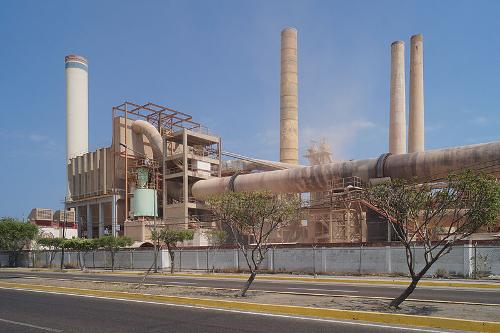 Venezuela cement plantPhoto: Rjcastillo CC 3.0 Unported no changes made
Venezuela cement plantPhoto: Rjcastillo CC 3.0 Unported no changes made
After World War II, the economy, traditionally oriented towards the processing of agricultural products, slowly expanded. A large-scale development of the natural resources and energy available (hydropower) began around 1960, with the development of the Guayana region in the east of the country;Ciudad Guayana became a center of heavy basic industry. The state-owned SIDOR blast furnace and steel complex processes nearby iron ore deposits of El Pao and Cerro Bolívar into pipes, sheet metal and cast iron. Aluminum is produced by the state-owned companies, which process the bauxite mined at Pijiguaos, among other things, in the Interalumina factory, the largest aluminum smelter in Latin America. Aluminum is the main export product after petroleum and steel. Venezuela is ninth in the world ranking of aluminum producers. Cement, glass and cellulose are also produced in Ciudad Guayana. A large part of the petroleum extracted in Venezuela is refined on site by about seventeen refineries.
Besides gasoline and heating oil, these refineries also supply raw materials for the fast-growing petrochemical industry. In addition to basic chemical products such as ammonia, ethane, propane, propylene and ethylene, two large petrochemical companies also manufacture fertilizers, pharmaceuticals, explosives, synthetic fibers and plastics. Cement production, which is not yet able to meet domestic demand, will be expanded with a new factory.
A center of metalworking industry is being developed at La Fría (state of Táchira), where castings for engines and machines are produced. The metalworking industry also produces automobiles, tractors, machinery, household electrical appliances and construction materials. Traditionally, the textile industry is important. The food, beverages and tobacco industry produces beer, cornmeal, canned fish, dairy products, animal feed, tobacco products, canned fruit, edible oils and fats. The industry also produces glass, paper, rubber, pharmaceutical products, leather goods and dyes. The main industrial centers include Valencia, Caracas, Ciudad Guayana, Maracaibo and San Cristóbal.
Trade and traffic
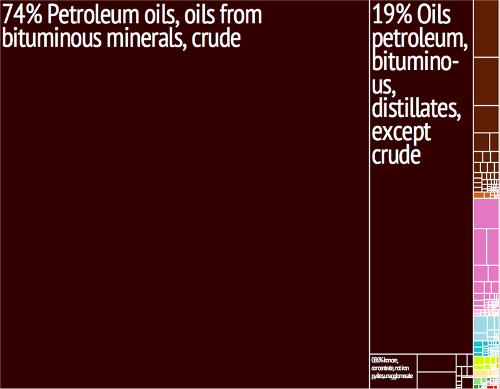 Export VenezuelaPhoto: R. Haussmann, Cesar Hidalgo, et.al CC 3.0 Unported no changes made
Export VenezuelaPhoto: R. Haussmann, Cesar Hidalgo, et.al CC 3.0 Unported no changes made
Oil is the most important export product, followed by aluminum and iron ore. Exports amounted to $ 32.1 billion in 2017, and the main export partners were the United States, China Colombia, India, the Netherlands Antilles, Singapore and Cuba.
Machinery, means of transport, raw materials, semi-finished products and foodstuffs are the most important import products. Traditionally, the United States has been the largest import partner;other important partners are China, Japan and Brazil. The value of the imports was $ 11 billion in 2017.
Venezuela has a pretty good road network. Of the approx. 100,000 km road length, 80% can be used all year round and almost 40,000 km is asphalted or has a concrete road surface. Modern motorways in and around Caracas connect the capital with all major cities. Buses provide passenger transport over longer distances, while in the cities and on short distances, the scheduled taxi provides most of the passenger transport.
In 1989, a 50 km underground in Caracas was put into use. In 1990, 336 km of railway were officially in use, but poor maintenance made these connections unreliable. The main seaports are La Guaira, Puerto Cabello and Maracaibo;the oil ports are Punta Cardón, Amuay and Las Piedras. Puerto Ordaz on the Río Orinoco is the export port of iron ore and aluminum that is accessible to sea-going vessels. Maracaibo has also been accessible to seagoing vessels since the canalization of the navigation channel between Lake Maracaibo and the Caribbean Sea.
For air transport are approx. 300 airports and landing strips available;of these, five are suitable for international air traffic, including the national airport Aeropuerto Internacional Simón Bolívar at Maiquetía, 35 km from Caracas. Private aircraft are increasingly responsible for domestic air traffic. Crude oil and natural gas are transported via more than 8,500 km of pipelines.
Sources
Dydyñski, K. / Venezuela
Lonely Planet
Ferguson, J. / Venezuela : mensen, politiek, economie, cultuur
Novib
Launspach, W. / Reishandboek Venezuela, Margarita
Elmar
Morrison, M. / Venezuela
Chelsea House Publishers
O’Bryan, L. / Venezuela, Isla Margarita
Gottmer
CIA - World Factbook
BBC - Country Profiles
Copyright: Team The World of Info